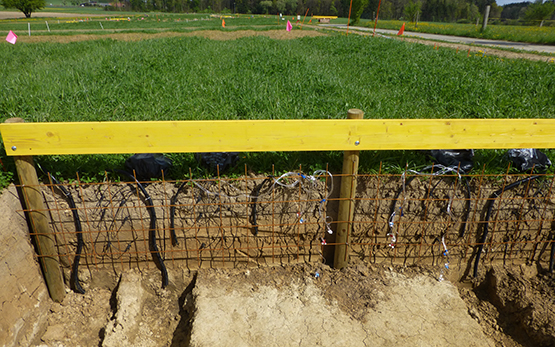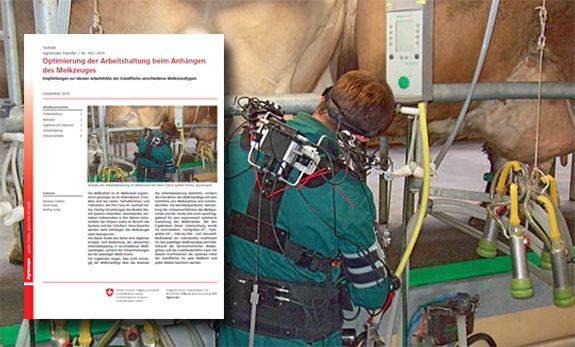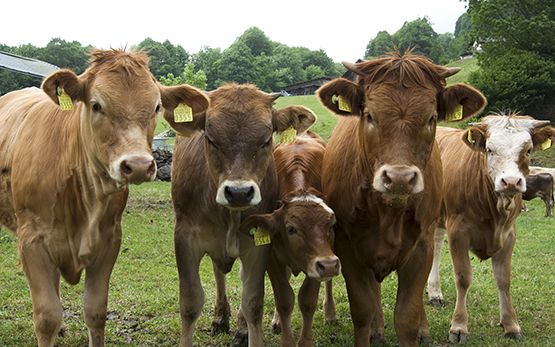Heller O., Di Bene C., Nino P., Huyghebaert B., Arlauskienė A., Castanheira N. L., Higgins S., Horel A., Kir A., Kizeková M., Lacoste M., Munkholm L. J., O'Sullivan L., Radzikowski P., Rodríguez-Cruz M. S. et autres
Towards enhanced adoption of soil‐improving management practices in Europe.
European Journal of Soil Science, 75, (2), 2024, 1-17.
Jarvis N., Coucheney E., Lewan E., Kloeffel T., Meurer K.H.E., Keller T., Larsbo M.
Interactions between soil structure dynamics, hydrological processes, and organic matter cycling: A new soil‐crop model.
European Journal of Soil Science, 75, (2), 2024, 1-24.
Heller O.
Inventory of sustainable Soil Management Practices: Considerations for selecting soil management practices to tackle multiple soil related challenges.
Dans: EUFRAS Webinar. 16. April, Ed. EUFRAS / EJP SOIL, Webinar. 2024, 1-17.
Rubeaud C., Kay S., Jarosch K., Walder F.
Soil health in Swiss agroforestry systems.
Dans: Jagrestagung SGP/SSP BGS/SSP SGPW/SSA. 21 March, Zollikofen. 2024, 1.
Heller O., Schittli D., Bragazza L., Ghiasi S., Guillaume T., van der Heijden M., Köstel J. K., Mayer J., Wittwer R., Keller T.
Can we manage soil structure for improved resistance against droughts and extreme rainfall events?: Preliminary results from the SoilX Project.
Dans: BGS Tagung 2024. 21 March, Zollikofen. 2024, 1.
Jordan-Meille L., Denoroy P., Dittert K., Cugnon T., Quemada M., Wall D., Bechini L., Marx S., Oenema O., Reijneveld A., Liebisch F., Diedhiou K., Degan F., Higgins S.
Comparison of nitrogen fertilisation recommendations of West European countries.
European Journal of Soil Science, 74, (6), 2024, 1-38.
Alakukku L., Heitman J., Horn R., Jansen B., Keller T., McKenzie B. M., Neollemeyer E., Peng X., Wendroth O.
Soil & Tillage Research Editorial.
Soil & Tillage Research, 237, 2024, 1-2.
Jarosch K., Hirte J., Walder F.
ARTEMIS: Agro-ecological strategies for promoting climate change Mitigation and Adaptation by enhancing soil ecosystem services and sustainable crop production.
Dans: EJP SOIL Annual Science Days. 12 June, Ed. Agroscope, Riga. 2023.
Thorsøe M. H., Keestra S., De Boever M., Buchová K., Bøe F., Castanheira N. L., Chenu C., Cornu S., Don A., Fohrafellner J., Farina R., Fornara D., da Conceição Gonçalves M., Graversgaard M., Heller O. et autres
Sustainable soil management: Soil knowledge use and gaps in Europe.
European Journal of Soil Science, 74, (6), 2023, 1-21.
Kreuzer A., Heller O.
Beurteilung von Versuchsflächen am Beispiel der Agroscope-Versuchsflächen Ost.
Ed. Agroscope, 2023, 33 pp.
Higgins S., Keesstra S. D., Kadziuliene Z., Jordan-Meille L., Wall D., Trinchera A., Spiegel H., Sanden T., Baumgarten A., Jensen J. L., Hirte J., Liebisch F., Klages S., et al.
Stocktake study of current fertilisation recommendations across Europe and discussion towards a more harmonised approach.
European Journal of Soil Science, 74, (5), 2023.
Heller O., Suter D., Zimmermann R., Kreuzer A.
Bodenkarten der Agroscope-Versuchsflächen OST: Digitale Bodenkarten und Bodenprofile der Standorte Reckenholz, Tänikon, Ellighausen und Oensingen.
Agroscope Science, 174, 2023, 1-3.
Bütikofer N.
Swiss farmers’ views on the role of soil management to mitigate impacts of droughts and extreme precipitation.
Ed. Universität Bern, 2023, 98 pp.
Sjulgård H., Keller T., Garland G., Colombi T.
Relationships between weather and yield anomalies vary with crop type and latitude in Sweden.
Agricultural Systems, 211, 2023, 1-9.
Blomquist J., Englund J.-E., Sjöberg C., Kårhammer J., Svensson S.-E., Pettersson E., Keller T., Berglund K.
Structure liming reduces draught requirement on clay soil.
Soil and Tillage Research, 231, 2023, 1-6.
Farahani-Kofoet, R. D., Häfner F., Feller C.
Effect of Organic and Mineral Soil Additives on Asparagus Growth and Productivity in Replant Soils.
Agronomy, 13, (6), 2023, 1-13.
Burgos S. , Dakhel-Robert N. , Weisskopf P. , Kellermann L. , Niggli J., Johannes A., van Geijtenbeek S. , Spuhler M. , Nilles L. , Bünemann-König E. , Heller O.
Spatenprobe BodenDok – Bewertung der Beobachtung (Dokument 4).
Ed. BFH, Agridea, FiBL und Agroscope, April, 2023, 11 pp.
Burgos S., Dakhel-Robert N., Weisskopf P., Johannes A., Kellermann L., Niggli J., van Geijtenbeek S., Spuhler M., Nilles L., Bünemann-König E., Heller O.
Spatenprobe BodenDok – Erläuterungen und Beispielbilder (Dokument 3).
Ed. BFH, Agridea, FiBL und Agroscope, April, 2023, 3 pp.
Burgos S., Dakhel-Robert N., Weisskopf P., Johannes A., Kellermann L., Niggli J., van Geijtenbeek S., Spuhler M., Nilles L., Bünemann-König E., Heller O.
Spatenprobe BodenDok – Formular (Dokument 2).
Ed. BFH, Agridea, FiBL und Agroscope, April, 2023, 2 pp.
Burgos S., Dakhel-Robert N., Weisskopf P., Johannes A., Kellermann L., van Geijtenbeek S., Spuhler M., Niggli J., Nilles L., Bünemann-König E., Heller O.
Spatenprobe BodenDok – Anleitung Entnahme mit Spaten (Dokument 1).
Ed. BFH, Agridea, FiBL und Agroscope, April, 2023, 2 pp.
Heller O., ten Damme L., D'Hose T., Euteneuer P., Fér M., Goberna M., Jarvis N., Keller T., Köstel J. K., Mehdi-Schulz B., Munkholm L.J.
Management impacts on soil structure: Evidence from twelve European long-term experiments.
Dans: BONARES Conference. 15. Mai, Berlin. 2023, 1.
Johannes A., Sauzet O., Matter A., Boivin, P.
Soil organic carbon content and soil structure quality of clayey cropland soils: A large‐scale study in the Swiss Jura region.
Soil Use and Management, 39, 2023, 707-716.
Häfner F., Monzon Diaz O., Tietjen S., Schröder C., Krause A.
Recycling fertilizers from human excreta exhibit high nitrogen fertilizer value and result in low uptake of pharmaceutical compounds.
Frontiers in Environmental Science, 10, 2023, 1-21.
Vanino S., Pirelli T., Di Bene C., Bøe F., Castaheira N., Chenu C., Cornu S., Feiza V., Fornara D., Heller O., Kasparinskis R., Keesstra S., Lasorella M. V., Madenoğlu S., Meurer K.H.E. et autres
Barriers and opportunities of soil knowledge to address soil challenges: Stakeholders’ perspectives across Europe.
Journal of Environmental Management, 325, (B), 2023, 1-9.
Blanchy G., Albrecht L., Bragato G., Jarvis N., Köstel J. K.
Open Tension-disk Infiltrometer Meta-database (OTIM).
Ed. BONARES, 30. Februar, 2022
Luster J., Crockford L., Keller T., Muñoz-Rojas M., Wollschläger U.
Editorial: Eurosoil 2021: Sustainable management of soil functions as a basis to avoid, halt, and reverse land degradation.
Frontiers in Environmental Science, 10, 2022, 1-3.
Daverkosen L., Holzknecht A., Friedel J. K., Keller T., Strobel B. W., Wendeberg A., Jordan S
The potential of regenerative agriculture to improve soil health on Gotland, Sweden.
Journal of Plant Nutrition and Soil Science, 185, (6), 2022, 901-914.
Doetterl S., Abramhoff R., Cornelis J., Frossard A., Fiener P., Garland G., Kaiser M., Laub M., Opfergelt S., Van de Broek M., van den Broek S., von Fromm S.
Understanding soil organic carbon dynamics at larger scales.
Dans: Understanding and fostering soil carbon sequestration. Ed. Dr C. Rumpel, Burleigh Dodds Science Publishing. 2022, 115-182.
Heller O., Vanwindekens F., Di Bene C., Nino P.
The potential of soil management practices to address soil challenges across Europe.
Dans: 22nd World Congress of Soil Science. 3. August, Ed. British Society of Soil Science, Glasgow. 2022, 1-22.
Cavalieri-Polizeli K.M.V., Marcolino F.C., Tormena C.A., Keller T., de Moraes A.
Soil structural quality and relationships with root properties in single and integrated farming systems.
Frontiers in Environmental Science, (10), 2022, 1-10.
MacLaren C., Mead A., van Balen D., Claessens L., Etana A., de Haan J., Haagsma W., Jäck O., Keller T., Labuschagne J., Myrbeck Å., Necpalova M., Nziguheba G., Six J., Strauss J. et autres
Long-term evidence for ecological intensification as a pathway to sustainable agriculture.
Nature Sustainability, 2022, 1-13.
Vanwindekens F., Heller O., Di Bene C., Nino P., Huyghebaert B.
Innovative Soil Management Practices across Europe: Final Report of i-SoMPE.
Ed. EJP SOIL, CRA-W, Belgium. February 1st, 2022, 135 pp.
Häfner F., Hartung J., Möller K.
Digestate Composition Afecting N Fertiliser Value and C Mineralisation.
Waste and Biomass Valorization, (13), 2022, 3445-3462.
Garré S., Blanchy G., Jarvis N., Larsbo M., Meurer K., Lewan L., Koestel J., Albrecht L., di Bene C., Nino P., Bragato G., Bonati G., Farina R., Pellegrini S., O'Keefe S et autres
Climate Change Adaptation Through Soil and Crop Management: Synthesis and Ways Forward.
Ed. EJP Soil, 31. Januar, 2022, 248 pp.
Sjulgård H., Colombi T., Keller T.
Spatiotemporal patterns of crop diversity reveal potential for diversification in Swedish agriculture.
Agriculture Ecosystems and Environment, 336, 2022, 1-7.
Bösch Y., Jones C. M., Finlay R., Karlsson M., Larsbo M., Keller T., Hallin S.
Minimizing tillage modifies fungal denitrifier communities, increases denitrification rates and enhances the genetic potential for fungal, relative to bacterial, denitrification.
Soil Biology and Biochemistry, 170, 2022, 1-10.
Heller O., Kiba D. I., Zida K. W., Schneider K., Kouame H. K. V., Traoré O. Y. A., Siegrist M., Frossard E.
Interdisciplinary Assessment of Market Oriented Yam Cultivation in Semi-arid Burkina Faso.
Frontiers in Agronomy, 4, 2022, 1-13.
Heller O.
Interdisciplinary assessment of market oriented yam cultivation in Semi-arid Burkina Faso.
Dans: BQBN-GSF Seminar. 03. Mai, Agroscope. 2022.
Heller O., Weiss L., Di Bene C., Vanwindekens F.
i-SoMPE: Innovative Bodenbewirtschaftung in Europa – Ein Überblick.
Dans: BGS Jahrestagung. 31. März, Bodenkundliche Gesellschaft der Schweiz BGS. 2022.
Heller O.
i-SoMPE - WP 1: Preliminary inventory and framework for practice assessment.
Dans: i-SoMPE Abschlussworkshop. 16. März, EJP SOIL. 2022, 1-22.
Heinze W. M., Mitrano D. M., Lahive E., Köstel J. K., Cornelis G.
Nanoplastic Transport in Soil via Bioturbation by Lumbricus terrestris.
Environmental Science & Technology, 55, (25), 2021, 16423-16433.
Jacob M., Maenhout P., Verzandvoort S., Ruysschaert G., Peter N., Heller O., Garland G., Weisskopf P.
Report on identified regional, national and European aspirations on soil services and soil functions.
Ed. EJP SOIL, INRAE, France. 30 March, 2021, 182 pp.
Munkholm L., Zechmeister-Boltenstern S., Heller O.
Set of reports on State of knowledge in agricultural soil management.
Ed. EJP SOIL, INRAE, France. 30 March, 2021, 110 pp.
Hvarregaard Thorsøe M., Jacobs A., Piccini C., Fornara D., Mason E., Vanwindenkens F., Bøe F., Siebielec G., Fohrafellner J., Miloczki J., Meurer K., Kasper M., O'Sullivan L., Sviček M., Gonçalves M. et autres
Report on the current availability and use of soil knowledge.
Ed. EJP SOIL, INRAE, France. 30 March, 2021, 122 pp.








